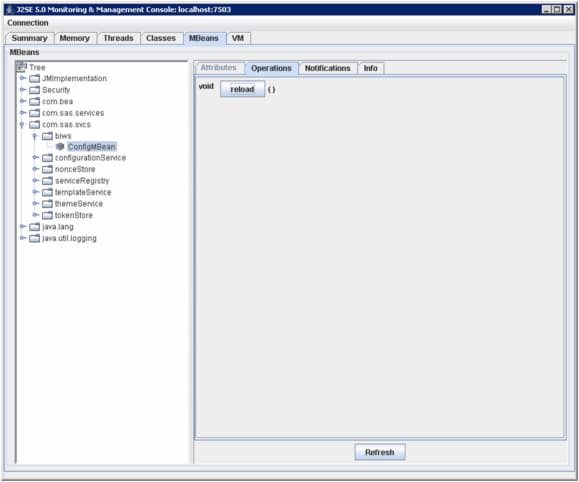Configuring SAS BI Web Services for Java
SAS BI Web Services for
Java is initially configured during installation using the SAS Deployment
Wizard. To modify this initial configuration, use the Configuration
Manager plug-in for SAS Management Console.
To modify common configuration
properties that apply to XMLA, WebServiceMaker, and generated Web
services, go to SAS Management Console. Navigate to Application Management  Configuration
Manager
Configuration
Manager SAS Application Infrastructure
SAS Application Infrastructure BI Web Services for Java 9.3.
Right-click to select Properties and select
the Settings tab.
BI Web Services for Java 9.3.
Right-click to select Properties and select
the Settings tab.
In the Application General Configuration section, you can modify the following configuration
properties:
General Configuration section, you can modify the following configuration
properties:
Acceptable SYSCC List
When a Web service
operation is invoked, it in turn calls the appropriate SAS Stored
Process running on the server tier. SAS execution always returns
the SYSCC macro variable upon completion. By default, if this completion
code is not 0, a SOAP fault is generated and returned to the invoking
client. Alternatively, a comma-separated list of acceptable SAS completion
codes can be specified to alter this behavior. Also, a hyphen separating
two values can be used to conveniently specify a range of acceptable
completion codes. In this case, the acceptable list of completion
codes are treated as warnings rather than errors and do not cause
a SOAP fault.
Note that SYSCC can
be set directly by SAS code developers. Likewise, some SAS procedures
set this value, so see the appropriate SAS documentation to determine
possible values that might be returned and whether these values are
errors or warnings. For example, if a SAS procedure states that a
SYSCC value less than 4 is a warning and you are willing to accept
those values, set this property as follows: 0-4. Therefore, if the
SAS stored process returns a value of 4 or less, it is considered
successful as far as the Web service is concerned and the client receives
an appropriate response rather than a fault.
Enable dynamic prompts validation
When invoking Web service
operations for stored processes that have been configured with dynamic
prompt data parameters, you can turn off validation to obtain better
throughput if you are certain that these stored processes have been
written in a robust manner to handle any possible data passed by clients.
Dynamic prompt validation is enabled by default so that the middle-tier
Web service validates client data against data providers to ensure
that incoming data meets the specified criteria before calling the
appropriate stored process on the server.
SAS Stored Process timeout
Set this property if
you want to limit the amount of time that a stored process is allowed
to run. If the stored process fails to execute in the specified time,
it is canceled and a SOAP fault is returned to the invoking client.
A value of zero indicates no time-out period.
To modify configuration
properties that are specific to the Web Service Maker, navigate to
the WebServiceMaker folder. Then, navigate
to the Settings tab within the Properties dialog
box.
Base namespace
This property is the
base namespace that is concatenated with the service name to create
a target namespace to uniquely identify generated Web services. For
example, if the base namespace is set to
http://tempuri.org,
and a client creates a new service named test without
specifying an overriding namespace for this new service, then the
target namespace for this Web service becomes http://tempuri.org/test.
Attachment conformance
Specifies the attachment
conformance that should be enabled for generated Web services. There
are two options: Message Transmission Optimization Mechanism (MTOM)
and SOAP Messages with Attachments (SWA). The default is MTOM.
Validate Request With Schema
Setting this property
to True causes the incoming request to be validated against the service’s
schema. The default is false because this operation can be CPU intensive.
Validate Response With Schema
Setting this property
to True causes the resulting output created by the service execution
to be validated against the service’s schema. The default is
false because this operation can be CPU intensive.
Attachment Optimized Threshold
The default value is
2048 bytes. This attachment threshold is the number of bytes contained
in the attachment that causes the data to be included as an out-of-band
XOP/Include MTOM attachment. An attachment containing fewer bytes
is transferred inline as base64 encoding for optimization.
To modify configuration
properties that are specific to a generated Web service, navigate
to the folder for that service. Then navigate to the Advanced tab
within the Properties dialog box. Specify
the name of each configuration property and its value in the Define
New Property dialog box.
The following advanced
configuration properties are available:
AcceptSysccList
See Acceptable SYSCC List. This property overrides its analogous common configuration
property.
DynamicPromptsSupport
See Enable dynamic prompts validation. This property overrides its analogous common configuration
property.
MaxSTPExecTime
See SAS Stored Process timeout. This property overrides its analogous common configuration
property.
AnonymousExecution
Enabled by default.
This property requires the SAS Anonymous Web user or Webanon account
to have been created previously.
BaseNameSpace
This property is the
base namespace that is concatenated with the service name to create
a target namespace to uniquely identify generated Web services. For
example, if the base namespace is set to
http://tempuri.org,
and a client creates a new service named test without
specifying an overriding namespace for this new service, then the
target namespace for this Web service becomes http://tempuri.org/test.
AttachmentConformance
This property specifies
the attachment conformance that should be enabled for generated Web
services. There are two options: Message Transmission Optimization
Mechanism (MTOM) and SOAP Messages with Attachments (SWA). The default
is MTOM.
ValidateRequestWithSchema
Setting this property
to true causes the incoming request to be validated against the service’s
schema. The default is false, because this operation can be CPU intensive.
Changes to properties
do not take effect immediately. To apply these changes, perform one
of the following tasks:
Copyright © SAS Institute Inc. All rights reserved.
